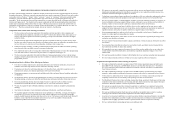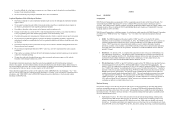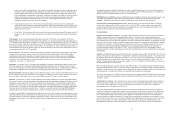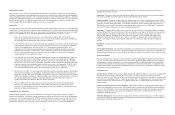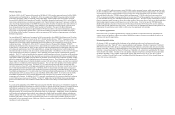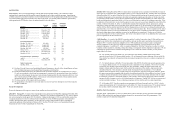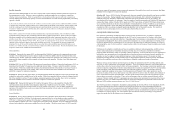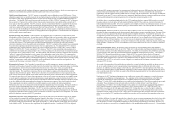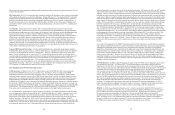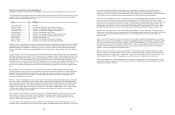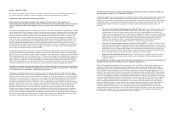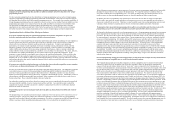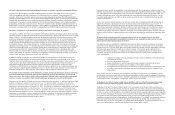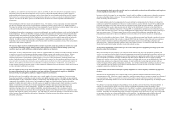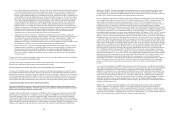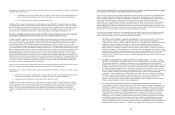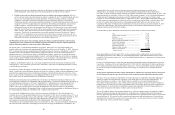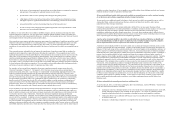Dish Network 2012 Annual Report Download - page 15
Download and view the complete annual report
Please find page 15 of the 2012 Dish Network annual report below. You can navigate through the pages in the report by either clicking on the pages listed below, or by using the keyword search tool below to find specific information within the annual report.
18
18
The International Telecommunication Union
Our satellite services also must conform to the International Telecommunication Union (“ITU”) service plans for
Region 2 (which includes the United States). If any of our operations are not consistent with this plan, the ITU will
only provide authorization on a non-interference basis pending successful modification of the plan or the agreement
of all affected administrations to the non-conforming operations. Certain of our satellites are not presently entitled
to any interference protection from other satellites that are in conformance with the plan. Accordingly, unless and
until the ITU modifies its service plans to include the technical parameters of our non-conforming operations, our
non-conforming satellites, along with those of other non-conforming satellite operators, must not cause harmful
electrical interference with other assignments that are in conformance with the ITU service plans.
Registration in the UN Registry of Space Objects
The United States and other jurisdictions in which we license satellites are parties to the UN Convention on the
Registration of Objects Launched into Outer Space. The UN Convention requires a satellite’s launching state to
register the satellite as a space object. The act of registration carries liability for the registering country in the event
that the satellite causes third party damage. Administrations may place certain requirements on satellite licensees in
order to procure the necessary launch or operational authorizations that accompany registration of the satellite. In
some jurisdictions, these authorizations are separate and distinct, with unique requirements, from the authorization
to use a set of frequencies to provide satellite services. There is no guarantee that we will be able to procure such
authorizations even if we already possess a frequency authorization.
Export Control Regulation
The delivery of satellites and related technical information for purposes of launch by foreign launch service
providers is subject to strict export control and prior approval requirements. We are required to obtain import and
export licenses from the United States government to receive and deliver certain components of direct-to-home
satellite television systems. In addition, the delivery of satellites and the supply of certain related ground control
equipment, technical services and data, and satellite communication/control services to destinations outside the
United States are subject to export control and prior approval requirements from the United States government
(including prohibitions on the sharing of certain satellite-related goods and services with China).
PATENTS AND OTHER INTELLECTUAL PROPERTY
Many entities, including some of our competitors, have or may in the future obtain patents and other intellectual
property rights that cover or affect products or services that we offer or that we may offer in the future. In general, if
a court determines that one or more of our products or services infringe intellectual property rights held by others,
we may be required to cease developing or marketing those products or services, to obtain licenses from the holders
of the intellectual property rights at a material cost, or to redesign those products or services in such a way as to
avoid infringing any patent claims. If those intellectual property rights are held by a competitor, we may be unable
to obtain the intellectual property rights at any price, which could adversely affect our competitive position.
We may not be aware of all intellectual property rights that our products or services may potentially infringe. In
addition, patent applications in the United States are confidential until the Patent and Trademark Office either
publishes the application or issues a patent (whichever arises first) and, accordingly, our products may infringe
claims contained in pending patent applications of which we are not aware. Further, the process of determining
definitively whether a claim of infringement is valid often involves expensive and protracted litigation, even if we
are ultimately successful on the merits.
We cannot estimate the extent to which we may be required in the future to obtain intellectual property licenses or
the availability and cost of any such licenses. Those costs, and their impact on our results of operations, could be
material. Damages in patent infringement cases can be substantial, and in certain circumstances can be trebled. To
the extent that we are required to pay unanticipated royalties to third parties, these increased costs of doing business
could negatively affect our liquidity and operating results. We are currently defending multiple patent infringement
actions. We cannot be certain the courts will conclude these companies do not own the rights they claim, that our
products do not infringe on these rights and/or that these rights are not valid. Further, we cannot be certain that we
19
19
would be able to obtain licenses from these persons on commercially reasonable terms or, if we were unable to
obtain such licenses, that we would be able to redesign our products to avoid infringement.
ENVIRONMENTAL REGULATIONS
We are subject to the requirements of federal, state, local and foreign environmental and occupational safety and
health laws and regulations. These include laws regulating air emissions, water discharge and waste management.
We attempt to maintain compliance with all such requirements. We do not expect capital or other expenditures for
environmental compliance to be material in 2013 or 2014. Environmental requirements are complex, change
frequently and have become more stringent over time. Accordingly, we cannot provide assurance that these
requirements will not change or become more stringent in the future in a manner that could have a material adverse
effect on our business.
SEGMENT REPORTING DATA AND GEOGRAPHIC AREA DATA
For segment reporting data and principal geographic area data for 2012, 2011 and 2010, see Note 17 in the Notes to
our Consolidated Financial Statements in Item 15 of this Annual Report on Form 10-K.
EMPLOYEES
We had approximately 35,000 employees at December 31, 2012, of which approximately 26,500 employees are
located in the United States. We generally consider relations with our employees to be good. Approximately 60
employees in three of our field offices have voted to have a union represent them in contract negotiations. While
we are not currently a party to any collective bargaining agreements, we are currently negotiating collective
bargaining agreements at these offices.
WHERE YOU CAN FIND MORE INFORMATION
We are subject to the informational requirements of the Exchange Act and accordingly file our annual reports on
Form 10-K, quarterly reports on Form 10-Q, current reports on Form 8-K, proxy statements and other information
with the SEC. The public may read and copy any materials filed with the SEC at the SEC’s Public Reference Room
at 100 F Street, NE, Washington, D.C. 20549. Please call the SEC at (800) SEC-0330 for further information on the
operation of the Public Reference Room. As an electronic filer, our public filings are also maintained on the SEC’s
Internet site that contains reports, proxy and information statements, and other information regarding issuers that file
electronically with the SEC. The address of that website is http://www.sec.gov.
WEBSITE ACCESS
Our annual reports on Form 10-K, quarterly reports on Form 10-Q, current reports on Form 8-K and amendments to
those reports filed or furnished pursuant to Section 13(a) or 15(d) of the Exchange Act also may be accessed free of
charge through our website as soon as reasonably practicable after we have electronically filed such material with,
or furnished it to, the SEC. The address of that website is http://www.dish.com.
We have adopted a written code of ethics that applies to all of our directors, officers and employees, including our
principal executive officer and senior financial officers, in accordance with Section 406 of the Sarbanes-Oxley Act
of 2002 and the rules of the SEC promulgated thereunder. Our code of ethics is available on our corporate website
at http://www.dish.com. In the event that we make changes in, or provide waivers of, the provisions of this code of
ethics that the SEC requires us to disclose, we intend to disclose these events on our website.


